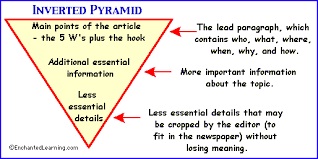Guidelines on Writing Newspaper Articles
Purpose
In this guide we provide basic tips on how to write a newspaper article, links to additional resources on how to write a newspaper article as well as a template
Parts of Newspaper Article
A newspaper article is usually constituted by five key parts:
- The headline is a short, attention getting statement about the event
- The byline tells who wrote the story
- The lead paragraph contains the what happened, where and when did it happen, who was involved, how did it happen, why is it newsworthy? Answers to these questions must be written in the opening sentences of the article and often provide the basis as to whether the reader continues with the rest of the story or not.
- The body/explanation comprises of the relevant facts or details that the intended audience needs to know after reading the headline and lead paragraph. Depending on the context of the event, it could include direct quotes from the researchers, study participants and or community stakeholders.
- The additional information part contains those details that are of least importance. In other words, these are details that even if the editor opted to delete from the article, the author would not have to rewrite it so as to convey the intended meaning.
How to Write a Newspaper Article
- Compile a Fact list
A fact list is an outline of all the pertinent facts and information that one needs to include in the article. Compiling a fact list is important to write a clean, succinct article and reduce chances of leaving out any relevant information about the topic or story.
- Use the inverted pyramid format
it is advisable to use the inverted format. This means that the most important vital facts should be mentioned first and the less important facts come later in the article. The first paragraph must more important than the second paragraph and the second paragraph more important that the third and so on.

Source: http://www.enchantedlearning.com/newspaper/invertedtriangle.GIF
- Check facts before concluding
Read over the article and where necessary provide support for all claims. Assertions need to be attributed to someone—“According to…..” Information that cannot be attributed to a reliable and appropriate source is not suitable for publication. Include names, dates and contact information or address.
- Remain unbiased
A news article is meant to convey direct facts, not the opinions of its writer. Keep your writing unbiased and objective. Avoid any language that is overly positive or negative or statements that could be construed as support or criticism.
- Concluding your article
Make sure your news article is complete and finished by giving it a good concluding sentence. This is often a restatement of the leading statement or a statement indicating potential future developments relating to the article topic.
- Keep it simple
No big words! Newspapers are written for twelve-year-old’s reading level in order to accommodate readers of all backgrounds and abilities.
- Every time is the first time
Provide background information. When writing about the latest in a series of events, do not assume precursory knowledge. Assume the reader is picking up the newspaper for the very first time, with no prior knowledge about a situation
References and additional resources
1. Westwood B, Westwood G: Assessment of newspaper reporting of public health and the medical model: a methodological case study. Health Promotion International 1999, 14(1):53-64.
2. Rainey DY, Runyan CW: Newspapers: a source for injury surveillance? American Journal of Public Health 1992, 82(5):745-746.
3. http://www.slideshare.net/gyg66/how-to-write-a-good-newspaper-article?related=1
4. http://www.wikihow.com/Write-a-News-Article
5. http://homeworktips.about.com/od/paperassignments/a/How-To-Write-A-News-Article.htm
6. http://www.coetail.com/jpahls/files/2011/10/How-to-Write-a-Newpaper-Arti...
Template for Writing a Newspaper article (adapted from www.primaryresources.co.uk/)